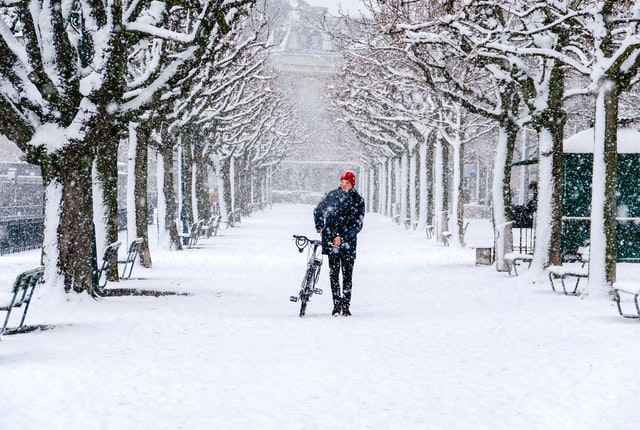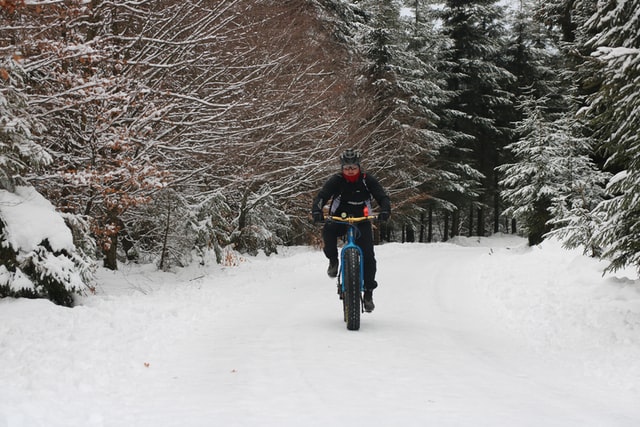Now that the cold and snowfall are more protagonists than ever in Spain, many of you will be interested in knowing how to ride on snow.
There will be a number of things to consider before and during rides, from the type of tire to the recommended techniques. All this in order to roll more safely;
Contents
The tires
One of the main concerns when riding in snowy areas is the grip that the tires can offer.
In the case of MTB, what is important is to have a wide tire that occupies more surfaces and therefore offers more grip.
But not everyone has a fat bike or snow-specific tires, so an alternative trick is to decrease tire pressure to increase the contact area.
It is also useful if the tires have a well-marked tread or even incorporate small studs, in the case of rolling on very snowy terrain.

Take care of your bike
Before and after a ride through the snow, make sure that the chain is well lubricated to counteract the cold and humidity.
This is also necessary if we are going to ride on a stretch of road where salt has been deposited. If the salt jumps out while we are riding it can end up on the chain and other parts of the bike, causing acceleration in the oxidation process.
In addition, it will be advisable to monitor the brakes during the outing since accumulated snow can turn into ice, limiting the braking capacity of our MTB.
For this reason, it is necessary to hit the brake lever or clean the affected area, from time to time, to avoid scares.
As for the pedals, it is advisable to use platform models, since they will allow us to quickly remove the foot in case of an unexpected slip of the wheels on ice. In this case, make sure that the pedals have ‘pins’ or some rough surface that improves the grip with the sole of the shoe.
If you are one of those who feel unable to ride without clip-less pedals, keep an eye on continuously that no snow accumulates between the pedal and the cleat. You run a high risk that this snow compacts and turns into ice, ‘welding’ your foot to the pedal which will cause, with full guarantee, a fall. Take your shoe off and hit the pedal every few minutes to loosen any embedded snow.
Snow and ice
Another important factor is to choose well the areas through which one is going to ride a bicycle. It should be noted that it is easier to roll on powder snow than on snow that is already more compact due to the cold.
Although when rolling in powder snow you also risk hitting rocks or other obstacles that have been covered; Because of that, it is best to ride on areas where other bikes or vehicles have already cleared the ground.
When it comes to ice, you have to be careful due to how slippery it is and how unpredictable it can be. Sometimes it is camouflaged in asphalt areas where it seems that there is nothing, especially where there is shade.
Tips on how to ride on snow
We want to know how to ride on snow on MTB; we advise you to follow the following driving and technical recommendations:
I) Roll slower. It will seem obvious but it is essential to moderate your speed to avoid scares and minimize the risks caused by ice or other obstacles. In addition, it is less tiring since riding fast forces you to make a greater effort to control the bike.
ii) Avoid sudden movements. Either turning the bike or braking, it is not advisable to be too aggressive, it is always better to perform gentle gestures.
iii) Lower the saddle. It is very likely that at some point we will have to depend on our feet to avoid slipping, so it is recommended that we can touch the ground without problems.
iv) Raise handlebar. It is advisable to have a more upright position on the bike, so you should have a high handlebar to reduce the weight on the front wheel and prevent slipping.
v) Use the rear brake. If you are going to brake hard, it is better to do it with the rear brake as there will be less risk of the rear tire skidding. The striker must be treated gently and very carefully.
Vi) Makes yourself visible. If the day is not good and visibility is bad, use lights and reflectors so that vehicles or people who are walking in the area can see you.
vii) Equip yourself well. With the appropriate clothes and with glasses that cover the face well, the cold will be better tolerated, especially on downhill sections. It is also advisable to protect the shoes so that they do not get wet with melted snow. Likewise, you must have water on hand for proper hydration since thirst is not so urgent but you sweat anyway.







